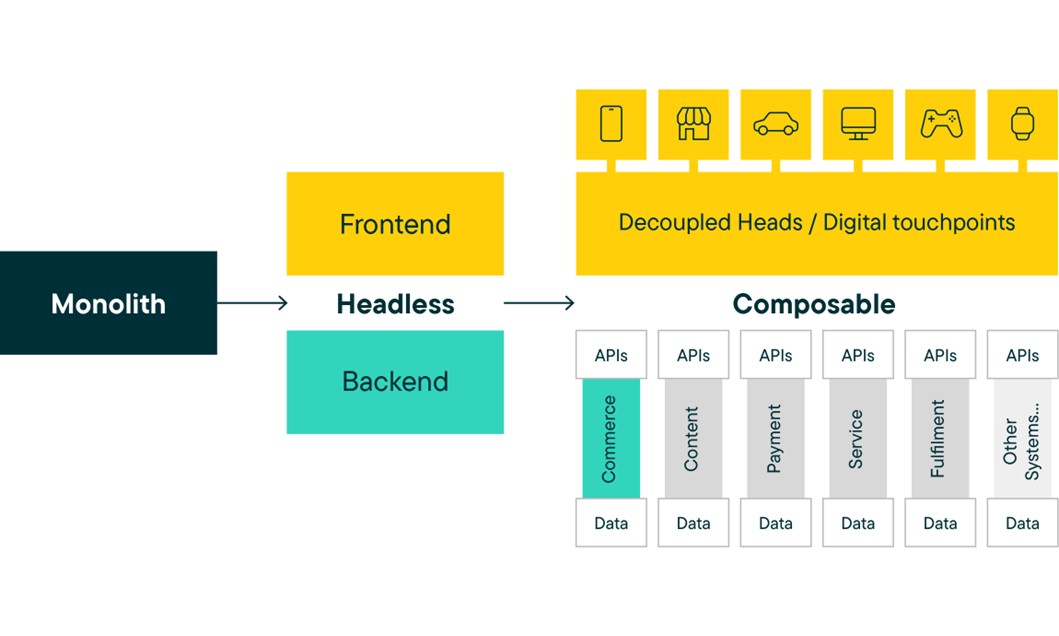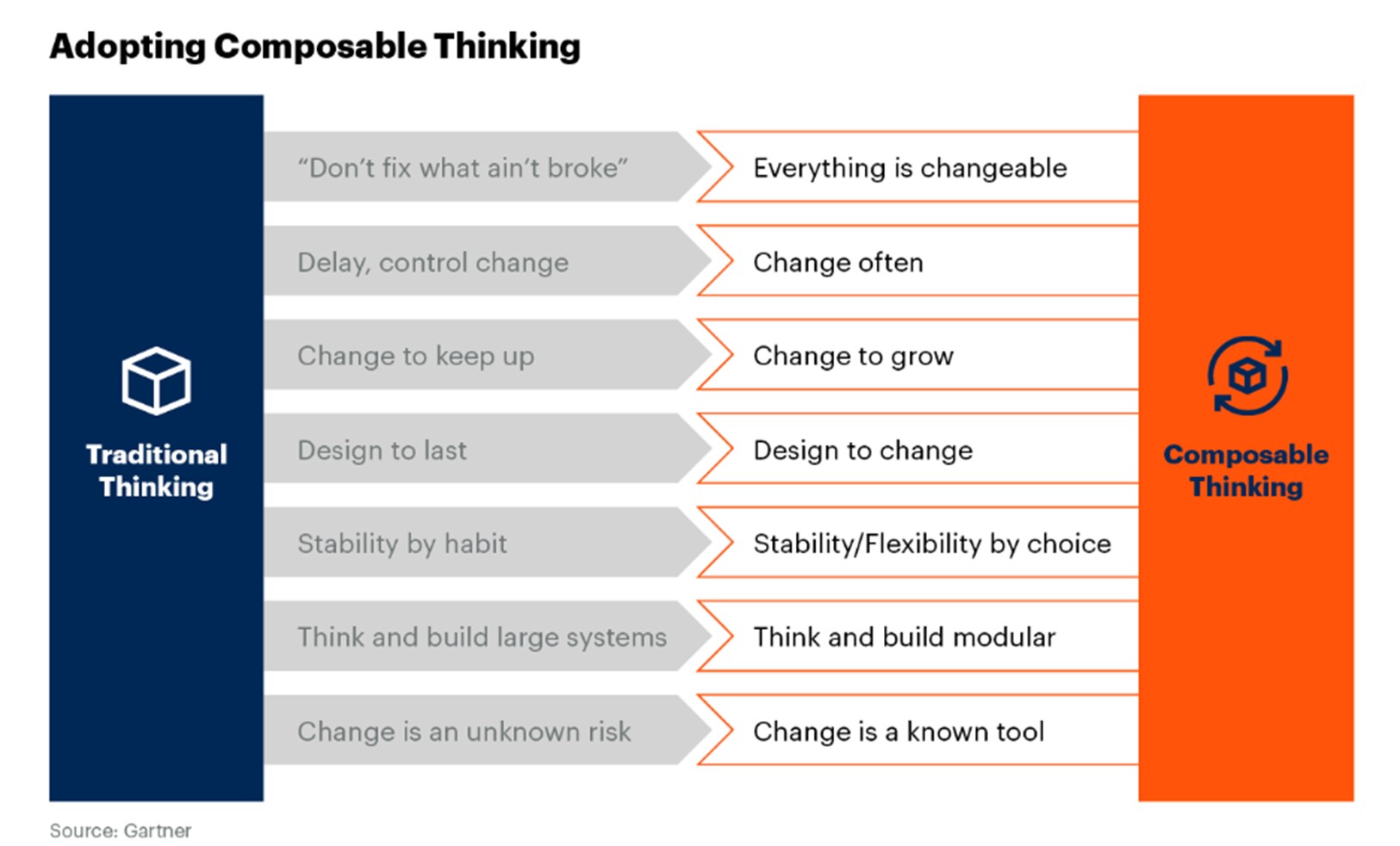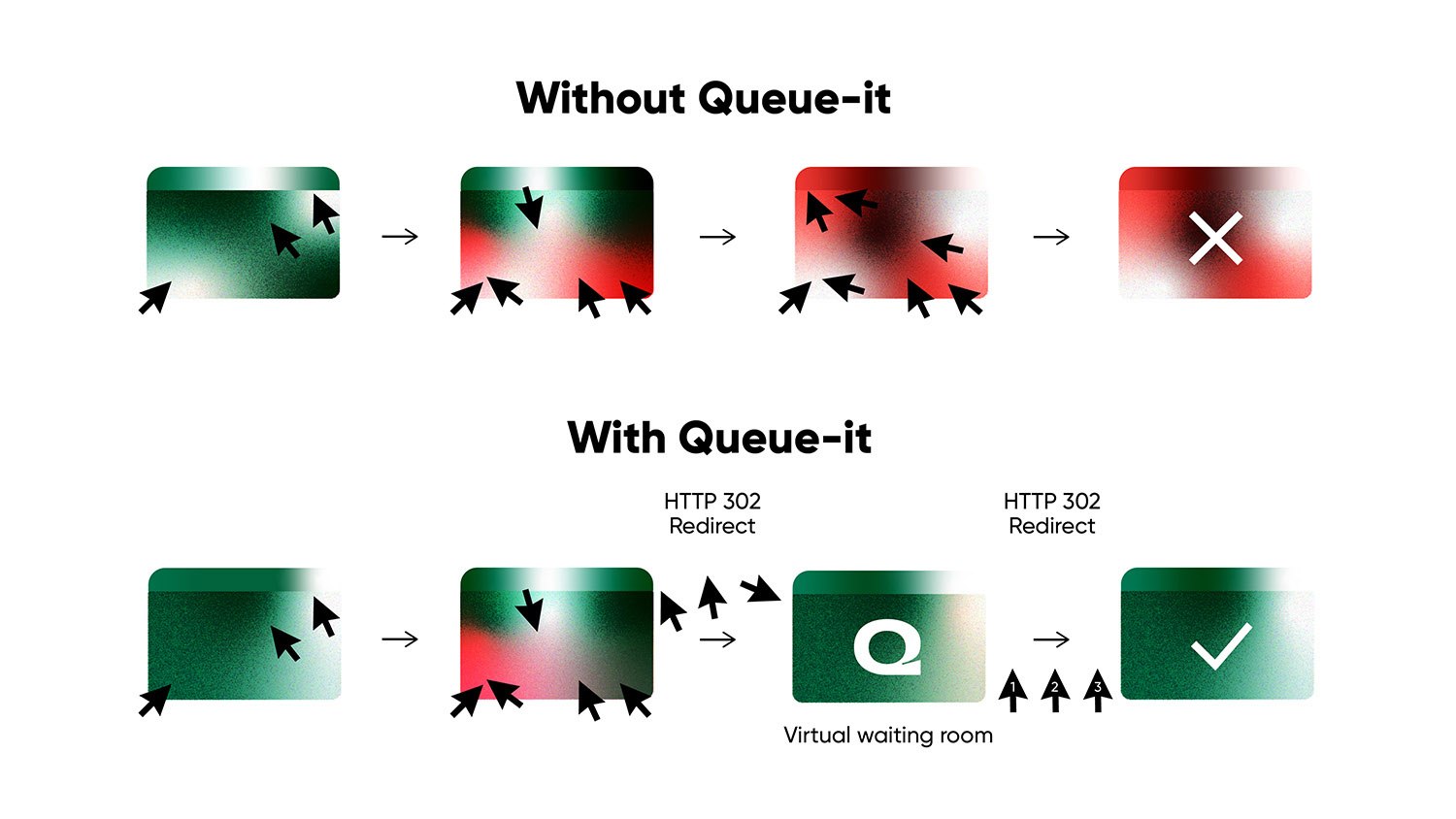Composable commerce: Definition, benefits & challenges

Enterprise retailers across the globe are rushing to adopt the composable commerce approach to ecommerce architecture and thinking. But what is composable commerce, how does it work, and what are the benefits of and challenges to successful composable migration? Get the answers to these questions and more in this comprehensive guide to composable commerce.
Table of contents
- What is composable commerce?
- How does composable commerce work?
- Key benefits of composable commerce
- Why composable commerce matters
- Composable commerce challenges
- How a virtual waiting room can help
Composable commerce is a build-your-own development approach to ecommerce architecture, where companies choose the best-suited components and combine (or “compose”) them into a custom application tailored to their needs.
Composable commerce is like designing your own house from the ground up with a combination of your favorite styles, features, and structures tailored to perfectly suit your needs. It lets ecommerce companies draw on the best tools and services to deliver a user experience that’s completely customized to their use case and customer preferences.
It stands in contrast to monolithic commerce systems, which are more like the one-size-fits-all approach of buying a pre-built house off the lot. Composable is also different from headless commerce, as it involves a further decoupling of systems, beyond just the frontend and backend.

Source: Commerce Tools
Composable has become the dominant framework for ecommerce architecture, with 72% of U.S. retailers already using composable commerce in some way, and another 21% planning to adopt it within the next year. Retailers across the globe are shifting to composable platforms for the flexibility, agility, and scalability they offer.
RELATED: 87 Composable Commerce Statistics That Show The Future is Composable
Composable commerce architecture works through a range of independent microservices that communicate and work together using APIs. Microservices are the building blocks of a composable commerce system, and APIs connect these building blocks, allowing them to work together as a unified whole.
Companies with composable commerce architecture may use hundreds of individual microservices to fit their specific requirements. These microservices are typically packaged together as SaaS solutions, developed by best-in-class companies that specialize in a particular business function.
With a composable approach, you can have:
- Company X run your product information management system
- Company Y run your order management system
- Company Z run your payment gateway
Because each of these services are autonomous, you can update, swap, or customize them without a full system overhaul.
APIs (application programming interfaces) are the software intermediaries that allow these services to communicate with your system and work in unison. APIs not only allow collections of services to work together, but also can also boost performance and security by only calling on and passing information to a particular service when it’s needed.
Composable commerce platforms work like a smart home, filled with advanced tech designed to make your day-to-day life easier.
The microservices are all the individual pieces of tech that serve a specific purpose—your smart lightbulbs, doorbell, speakers, security systems, etc. The APIs are the software that enables these tools to work seamlessly together, so that when you leave for the day and lock your door, the security system automatically activates, the lights turn off, and your robot vacuum gets to work.
The key advantage of the composable commerce framework is the ability to work with many companies that are each the best at what they do. Your whole smart home (ecommerce platform) doesn’t have to be delivered by a single company to work well. Instead, you can have an Apple smart speaker, an Amazon doorbell, a Dyson vacuum, etc. and have them all work together.
Composable lets you pick the products or services that work best for you, without being limited to a single platform or software ecosystem. It lets you embrace change, rather than fear it.

Microservices and APIs are the two fundamental elements of composable commerce, but to reap the full benefits of composable systems, many retailers approach their architecture using the MACH framework.
If you’ve heard of composable commerce, you’ve probably heard of MACH. The two terms are often used interchangeably, but they’re distinct. Composable commerce is an approach to developing commerce platforms. MACH is a set of principles for choosing services that best suit a composable commerce system.
The MACH Alliance defines these four core principles as follows:
- Microservices: Individual pieces of business functionality that are independently developed, deployed, and managed.
- API-first: Built with APIs from the ground up. All functionality is exposed through an API.
- Cloud-native SaaS: Software-as-a-Service that leverages the full capabilities of the cloud, beyond storage and hosting, including elastic scaling of highly available resources. Functionality is updated automatically, no manual effort required.
- Headless: Front-end presentation is completely decoupled from back-end logic. Designed to be channel, programming language, and framework agnostic.
To build a composable commerce system, the services you use don’t have to be cloud-native or API-first. But the MACH Alliance encourages enterprise retailers to consider these additional criteria to build an enterprise tech stack where every component is pluggable, scalable, replaceable, and can be continuously improved.
RELATED: Why Composable Commerce Won’t Fix Your Scaling Challenges
The primary benefit of composable commerce architecture is the flexibility it creates. 29% of retail executives say the top benefit of composable is them the ability to make incremental changes, and another 28% say that it gives them the freedom to choose among best-of-breed solutions.
With composable, you can use one best-in-class service for your storefront, another for personalization, another for your CRM, another for your analytics, and so on and so forth. Netflix, for instance, runs on over 1,000 microservices.
The flexibility of composable also lets you avoid vendor lock-in. Not only can you work with dozens of different solutions, but if something isn’t working right, you can easily swap these solutions out without significant development work or waiting out large contracts.
In the fast-changing world of ecommerce, retailers must quickly embrace new trends like AI, augmented reality, social shopping, and subscription models to remain competitive.
Composable commerce makes it easier for retailers to keep up with consumer preferences and preserve their competitive edge. That's why 26% of retail execs say they adopted composable specifically to increase speed to market and address shifting consumer trends quickly.
Services designed for composable commerce architecture are often plug-and-play, meaning you can roll-out new features quickly without re-architecting systems or significant development. 30% of retail leaders said this “out-of-the-box functionality” was the most important criteria for choosing composable commerce solutions.
Breaking your architecture up into many small parts means you can update, scale, or replace each of these parts independently. It allows you to have a tech stack that grows with you.
The scalability of composable architecture doesn’t just apply to business activities, but also to site capacity and performance. By decoupling business functions and calling on them through APIs, user load becomes more distributed.
If services follow MACH framework and are cloud-native, you’ll also benefit from high levels of scalability and features like autoscaling. If done right, this can lead to significant savings on scaling costs (if done wrong, it can spike costs).
The separation of components also means that if one microservice crashes or fails, the whole system doesn’t fail with it. But as we’ll get to, this doesn’t make composable sites invulnerable to performance issues and crashes under extreme load.
While flexibility, agility, and scalability are all important benefits of composable commerce, they contribute to a higher-order benefit: improving the customer experience.
When asked about the biggest benefits seen from adopting composable, four of the top five responses from retail execs concerned customer experience:
- The ability to create highly differentiated digital experiences (30%)
- Improved customer satisfaction (30%)
- Ability to make incremental changes rather than undergoing a complete overhaul (29%)
- Consistent user experience across touchpoints (28%)
- Increased customer engagement (28%)
Composable makes it easier to change, scale, and adapt your ecommerce platform to your customers’ preferences. When properly embraced, composable empowers you to never fall behind or fall short on customer experience and expectations.
Composable commerce matters for retailers because it represents a fundamental shift in the approach to building enterprise architecture. Composable offers increased flexibility, agility, and scalability—all of which contributes to a competitive edge and better user experience.
The retailers who’ve embraced composable are thriving in the fast-changing ecommerce landscape. And those who aren’t are lagging behind.
Various surveys demonstrate just how important retail leaders believe composable is (and will continue to be):
- 96% of retail executives believe composable commerce will continue to be a prominent approach over the next five years.
- Just 4% think composable will be eclipsed by new tech solutions in that timeframe.
- 71% of ecommerce decision-makers say their ecommerce platform selection is a “high” or “top five strategic” priority for them.
- The number of retail leaders who strongly favor the composable or “best-of-breed” approach has more than doubled in the past two years.
- During the same period, the number of those who strongly favored the monolithic or “all-in-one” approach halved.
Composable commerce matters for vendors because it's changed the way major companies choose and buy software. For example, 90% of retail-decision makers now consider integration with outside systems a priority when choosing solutions.
This means big, previously monolithic companies like Salesforce and Shopify have had to pivot to allow integrations with an increasing number of third-party services.
Composable has also reduced vendor lock-in, and in turn, competition. Retailers are more willing than ever to change vendors to use services are easy to change, with out-of-the-box functionality, pre-built integrations, and low total cost of ownership.
While composable commerce can increase flexibility, agility, and performance, it also creates complexity. 69% of retail leaders said implementing a composable commerce solution took over six months, and another 27% said it took over a year.
By returning to our analogy of building your own home (composable commerce) vs. choosing a pre-built home (monolithic), we can see that composable commerce introduces countless decisions:
- Who is the best vendor for this service?
- How do we integrate, customize, and test it?
- How do we link it with existing services?
- Do we need training or internal experts to use the service?
- What subscription tier do we need?
- What security requirements do we have?
Where monolithic systems are/were used by hundreds or thousands of companies, the configuration of your composable tech stack may be completely unique to you. This means you’re often operating in uncharted territory. That’s why, when asked about challenges to implementing composable:
- 34% of retail leaders said it was hard to hire people with the right skills
- 32% said building and managing integrations took a long time
- 29% said building the front-end was time-consuming
- 29% said it was hard to manage vendors
- 27% said it was hard to select vendors
In the ideal composable world, every service would be completely plug-and-play. But in reality, you often need a lot of custom code, testing, and development to implement new services.
As Bettina Donmez, the Ecommerce Manager at Puma says:
“The user adoption for the older tech stack was in a lot of ways easier because it was mainstream … Everybody was doing it the same way. The moment you deviate from that common space is where you have to do custom. We had to hire people who do custom documentation, that look at custom features, that look into custom settings and configurations—hundreds of them!”
Migrating to composable is a massive project which involves a lot of resources, DevOps expertise, money, and time. And it isn’t a one-and-done process either. You need to monitor, maintain, and regularly test these services to ensure they’re all working as expected.
While composable commerce systems can enable companies to handle larger traffic volumes through the distribution of load and decoupling of frontend and backend, they’re far from invulnerable from crashes and bottlenecks.
You’re only as scalable as your smallest bottleneck. By increasing the number of services you rely on, you increase the risk of one of these services failing. So when large ecommerce sites crash today, it’s often caused by a failure in one or several of the microservices it uses.
Handling sudden traffic peaks with composable architecture is challenging because scaling, testing, failing gracefully, and restoring these services is complex:
- Scaling: All your critical services must be scaled to handle the desired throughput rate, which often involves contacting multiple vendors and potentially needing to upgrade subscription tiers.
- Testing: When your architecture is constantly changing, you need to constantly test it. But load tests can be expensive and challenging to run, especially as the complexity of your architecture increases.
- Restoring service: When a third-party service gets overloaded, you have little to no control over how quickly they restore service, meaning the failure can last a long time.
- Failing gracefully: It’s extremely challenging to fail gracefully with a composable commerce architecture because each service fails in its own way—some display error messages, others spinning wheels, others are just unresponsive. Partial failures can increase customer frustration, for example, when all parts of the user journey work except payment.
RELATED: 3 Autoscaling Challenges & How to Overcome Them with a Virtual Waiting Room
"Not all components of a technical stack can scale automatically, sometimes the tech part of some components cannot react as fast as the traffic is coming. We have campaigns that start at a precise hour … and in less than 10 seconds, you have all the traffic coming at the same time. Driving this kind of auto-scaling is not trivial."
ALEXANDRE BRANQUART, CIO/CTO

If you’re not careful, your composable architecture can get extremely complex. And the more complex your architecture is, the more complex scaling it becomes.
The more complex your architecture is, the more complex scaling it becomes.
As ecommerce evolves, so too do the attack vectors of those who seek to exploit it. Composable architecture involves dealing with more vendors, which can introduce more risk. Distributed architecture means the attack surface consists of more, smaller units, with more access points via APIs.
APIs are designed for programmatic access. They’re based on automated interaction between platforms. This makes them prime targets for bots, which are pieces of software that can be completely customized to follow the rules of a specific API.
Bots targeting an API, for example, could bypass the typical user flow and make a direct transactional API call to complete a transaction. Or they could abuse APIs to test stolen credit card information or login details in bulk—44% of account takeover attacks in 2023 targeted APIs specifically.
One survey found organizations manage an average of 300 APIs—and 70% of developers expect API usage to continue to grow. Many ecommerce companies use hundreds of APIs and know very little about what’s contained in each of them. The sheer scale of API endpoints not only gives bots more access points, but also makes it more difficult to effectively secure against all vulnerabilities.
RELATED: Everything You Need to Know About Preventing Online Shopping Bots
After overcoming the difficult process of migration, the main challenges of composable commerce typically emerge on or in preparation for retailers’ biggest days. When traffic surges suddenly, or bots launch an attack, the complexity of composable makes it difficult to scale uniformly, fail gracefully, test and troubleshoot problems, and quickly restore service.
That’s why major retailers like The North Face, SNIPES, and Zalando, use a virtual waiting room to control their online traffic and run major online events without the fear of failure. A virtual waiting room is a cloud-native SaaS solution that prevents website crashes and ensures fairness in high-demand situations like Black Friday sales, ticket onsales, and product drops and launches.
Virtual waiting rooms work by automatically redirecting visitors to an online queue when they perform an action the business wants to manage—such as visiting a landing page or proceeding to checkout—or when traffic spikes to levels that threaten site performance.

Visitors experience a short wait on a fully customizable queue page, then are flowed to your website or app in fair, first-in, first-out order.
RELATED: The Comprehensive Guide to Virtual Waiting Rooms: All Your Questions Answered
Virtual waiting rooms offer three key benefits that help you overcome the challenges of handling traffic spikes with a composable system.
- Control traffic flow: Keep your website running smoothly, simplify your load testing, and keep cloud computing costs under control by ensuring traffic arrives on your site at exactly the rate you choose.
- Protect key bottlenecks: Configure the waiting room to activate only when traffic hits a set threshold or just to protect tough-to-scale bottlenecks like the login or payment gateway.
- Mitigate API vulnerabilities: Run checks on visitors at any point in the user journey to validate that they’ve passed through the queue, been invited to the event, or have details that match those of visitors who’ve waited. You can configure the waiting room to protect your APIs so that bad actors cannot call on APIs without a valid token.
“Queue-it’s a great bolt-on piece of infrastructure, completely dynamic to our needs. The virtual waiting room made much more sense than re-architecting our systems to try to deal with the insanity of product drops that take place a few times a year.”
TRISTAN WATSON, ENGINEERING MANAGER

- Composable commerce is a build-your-own development approach to ecommerce architecture, where companies choose the best-suited components and combine (or “compose”) them into a custom application tailored to their needs.
- Composable commerce is the most recent stage in the journey of enterprise commerce systems from monolithic, to headless, to composable. The journey has essentially involved an increasing separation of components at each stage, to create more flexibility and agility.
- Composable commerce architecture works through a range of independent microservices that communicate and work together using APIs. Microservices are the building blocks of a composable commerce system, and APIs are what connect these building blocks, allowing them to work together as a unified whole.
- MACH stands for Microservices, API-first, Cloud-native SaaS, and Headless. These are the four characteristics of technologies that enable you to get the most out of composable commerce architecture.
- The three key benefits of composable architecture are flexibility, agility, and scalability—all of which contribute to a better customer experience. Because composable commerce systems are more flexible, they let you adapt to changes and roll out new features faster. Because you can do more, faster, composable is the ideal approach for any fast-growing retailer.
- The three key challenges to composable architecture are its complexity, the difficulty and expense of tackling performance issues, and API vulnerabilities. Relying on so many vendors and distinct components makes set-up, maintenance, testing, debugging, scaling, and security more challenging.
- Virtual waiting rooms can help with the weaknesses of composable commerce systems that emerge under peak load. They allow you to create a consistent flow of traffic through your systems, set-up fine-tuned protection of tough-to-scale bottlenecks, and prevent bots from abusing vulnerabilities created by APIs.